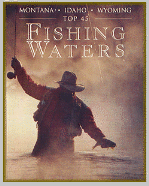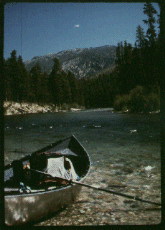

Picking Pockets
on the
Middle Fork
by Ed Mitchell
The Middle Fork of the Salmon River runs too wild to give up its golden treasures as a gentle spring creek does. You have to pick its pockets.
Wild cutthroat trout and 98 miles of some of the most technical whitewater in the country draw nearly 10,000 adventurers to central Idaho each year. Many more would be on the river, which splits the biggest wilderness in the Lower 48 states, if the Forest Service did not limit private boaters through a lottery system. Most river users agree that the Forest Service has done a good job of keeping the Frank Church River of No Return Wilderness wild. Only strict regulation of visitor numbers keeps the supply in balance with the demand for wilderness experience and the Middle Fork from becoming a whitewater freeway.
Westslope cutthroat, the predominant trout in the Middle Fork, take a fly or lure aggressively without the coy selectivity common to rainbows and browns. Their eagerness lends them an unusual charm but this forthright feeding habit led to their near demise in many western streams before they were given special protection. The fish's guileless enthusiasm, coupled with its appeal as the breakfast of choice for too many anglers, had the Middle Fork cutthroat on its way to oblivion by 1970.
Now the Middle Fork provides an excellent example of what can be done for a declining wild fishery where overharvest is the problem. Single, barbless hooks, no bait, and strict catch-and-release is the law.
 The Middle Fork's famous whitewater being the main attraction for most of its visitors, fishing seems to be a primary interest to a minority of floaters. Fishing from a raft is possible and many give it a try in the slower sections. The right answer fishing the Middle Fork is a driftboat, however. Driftboats ("hardboats" to distinguish them from rafts) provide a stable, dry and highly maneuverable fishing platform. Driftboats can be oared to traverse the river from side-to-side or to come to an almost complete stop. They are made for fishing with solid, flat-bottom footing and, usually, knee braces to help the angler stay upright in tricky water.
The Middle Fork's famous whitewater being the main attraction for most of its visitors, fishing seems to be a primary interest to a minority of floaters. Fishing from a raft is possible and many give it a try in the slower sections. The right answer fishing the Middle Fork is a driftboat, however. Driftboats ("hardboats" to distinguish them from rafts) provide a stable, dry and highly maneuverable fishing platform. Driftboats can be oared to traverse the river from side-to-side or to come to an almost complete stop. They are made for fishing with solid, flat-bottom footing and, usually, knee braces to help the angler stay upright in tricky water.
On waters as technical as the Middle Fork, however, driftboatmanship must be nearly perfect. When one of these craft fills, it sinks. Few amateurs qualify to take a driftboat down this river; not many outfitters offer this particular equipment and expertise. One who does is Solitude River Trips, a Merlin, Oregon-based company owned by Al and Jeana Bukowsky.
On one of their mid-summer trips down the river in mid-summer, it seemed to me that every reachable pocket of water held a fish. The number of fish caught and released in any day depended mostly on the number of casts I could make accurately.
Three of the 15 guests on this mixed-craft trip (we took oared and paddle rafts along with inflatable kayaks as well as the driftboats) declared their interest in fishing early. Art Kayser of Portland, Oregon was making his seventh trip down the Middle Fork, a favorite river in his flyfishing book that includes entries from Scotland, New Zealand and the Florida Keys as well as famous western trout waters.
Kayser summed up his reasons for returning to the Middle Fork by saying "the fishing is getting better every year instead of worse." With catch and release, the trout are "steadily getting larger." The angler can enjoy "the art of casting using "everything in your repertoire" as the river changes constantly from big water to pools, riffles and class rapids. "It's the feeling of the whole experience" that brings him back, he said.
The rest were there mostly to raft and kayak the whitewater, watch wildlife and take in the spectacular canyon. As soon as it became clear to all that cutthroat were abundant and cooperative, however, places in the driftboats took on a sudden desirability. One guest from the Midwest who had never flyfished became an ardent advanced beginner before the trip ended. Several others with limited long-rod experience learned to catch-and-release cutthroat like tournament professionals.
The upper end of the river beginning at the Boundary Creek launch bounces boats through almost constant whitewater, providing only limited holding water for small trout. By lunch time on launch day, the river will allow anglers to stand safely in a driftboat and cast to bigger fish. The river and its fish increase in size as the stream flows from its alpine headwaters through towering granite canyons to the Main Salmon.
Cutthroat tend to laziness, taking feeding positions in the stillest pockets of water. Unlike rainbows, they are seldom hooked in riffles. When cutts are present in hundreds, a flyfisher must only whisk the fly to calm pockets along banks, before and behind boulders and in deep pools. Constant line mending keeps the fly from dragging in the powerful currents in the middle of the river. A short cast usually proves most effective.
Wet flies work, as I proved when I dropped a SuperRenegade 10 feet down to the 14-incher in the brilliant green pool below Pistol Creek Rapids. But there is no reason to burden yourself with heavy dredging equipment when a nearly unsinkable #14 Elk Hair Caddis fished on a four- or five-weight double-taper line will take 50 fish in an afternoon. Superior buoyancy in the Elk Hair Caddis permits refloating the fly time after time so the angler need not haul the fly off the fish-filled water for many new casts.
Middle Fork water clarity lets the flyfisher see fish before casting, then watch the strike. Seeing the fish on its way to the fly is not always an advantage; it is easy even for old hands to feel the tension and rip the fly away from an oncoming hungry trout.
The river provides a perfect classroom for the beginner or anyone wishing to improve flyfishing skills. The target water areas show themselves clearly, if briefly, as the boat moves downriver.
No one on the trip kept a count of fish caught. Too many fish waiting for the next cast, too much scenery to see and more than enough whitewater-induced adrenaline made tallying numbers insignificant. Thirty to 50 per day, not counting four-inch salmon and steelhead smolts or the occasional squawfish, would be an accurate range for most of us. Kayser hooked about twice as many as anyone else.
As the river is the campus, the guides are its professors. All the guides oaring driftboats on this trip hailed from Oregon. The tradition of driftboating Oregonians on this Idaho river predates World War II. Besides the qualification of a lifetime of oaring hard boats in rocky, shallow rivers, each of these Oregon guides is a flytying, flyfishing fanatic with years of experience in both states. They help as much or as little as the guest requires while skillfully placing the boat within range of fish. To pick the Middle Fork's pockets, the angler needs a driftboat pilot who is an experienced accomplice.
In a state where a dad is more likely to buy his newborn a fly rod than a football, it seems all natives ought to know how to catch cutthroat on the Middle Fork of the Salmon River as a kind of birthright. After all, it is our river, running smack dab through the very heart and soul and center of Idaho. But there I stood, my heavy-duty flyfishing gear laid aside and using the guide's slick little 4-weight wand, humbly asking for one more of those devilishly effective caddis flies from the guide's hand-tied collection. More than that, I was casting to the pocket water within inches of the bank where he said fish would lie. He was right --- to the tune of 50 or 60 fish a day.
I cast to the current seam that carried the trout's accustomed meals past his slick-water lie, quickly mended the belly of the line upstream, then watched for that sudden golden flash that meant the offering was being grabbed.
Elk hair hoppers rated second to caddis, especially on the lower, more arid end of the river. Parachute Adams accounted for a fair share of fish but even this pattern is less buoyant than the elk hair types. The classic Royal Wulff proved an effective attractor on the one day when cutts did not care for elk hair.
Lures are legal as is spinfishing with a bubble and fly but there is no good reason to fish this way. You can cover far more water with a flyrod and have a vastly better time doing it. Besides, the guides discourage any method that does not involve flyrods and flies because of the potential for damage to fish. They care deeply about the resource and the future of their trade.

 The Middle Fork's famous whitewater being the main attraction for most of its visitors, fishing seems to be a primary interest to a minority of floaters. Fishing from a raft is possible and many give it a try in the slower sections. The right answer fishing the Middle Fork is a driftboat, however. Driftboats ("hardboats" to distinguish them from rafts) provide a stable, dry and highly maneuverable fishing platform. Driftboats can be oared to traverse the river from side-to-side or to come to an almost complete stop. They are made for fishing with solid, flat-bottom footing and, usually, knee braces to help the angler stay upright in tricky water.
The Middle Fork's famous whitewater being the main attraction for most of its visitors, fishing seems to be a primary interest to a minority of floaters. Fishing from a raft is possible and many give it a try in the slower sections. The right answer fishing the Middle Fork is a driftboat, however. Driftboats ("hardboats" to distinguish them from rafts) provide a stable, dry and highly maneuverable fishing platform. Driftboats can be oared to traverse the river from side-to-side or to come to an almost complete stop. They are made for fishing with solid, flat-bottom footing and, usually, knee braces to help the angler stay upright in tricky water.